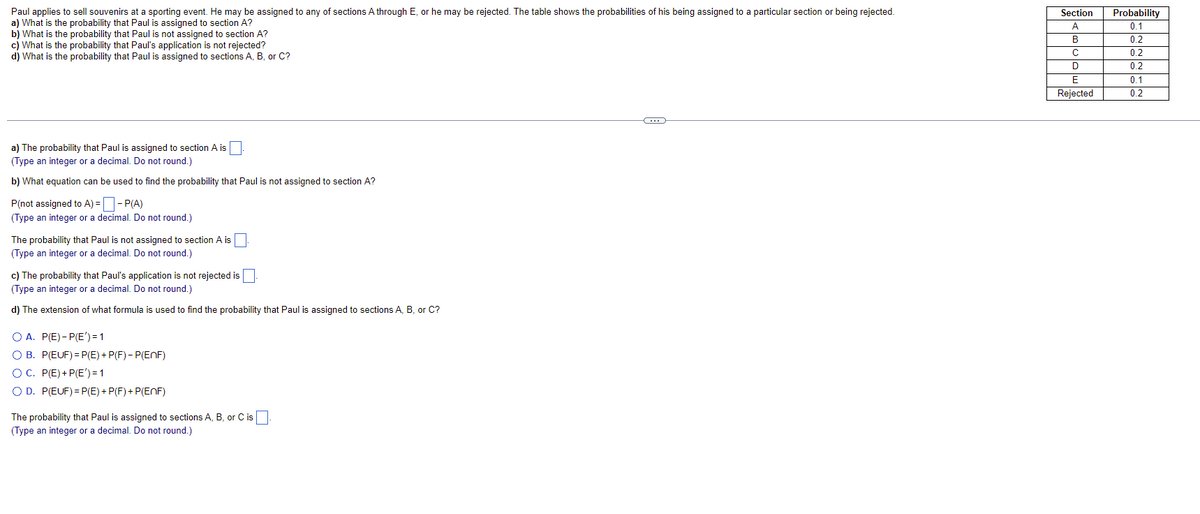a) What is the probability that Paul is assigned to section A? b) What is the probability that Paul is not assigned to section A? c) What is the probability that Paul's application is not rejected? d) What is the probability that Paul is assigned to sections A, B, or C? a) The probability that Paul is assigned to section A is (Type an integer or a decimal. Do not round.) b) What equation can be used to find the probability that Paul is not assigned to section A? P(not assigned to A)--P(A) (Type an integer or a decimal. Do not round.) The probability that Paul is not assigned to section A is (Type an integer or a decimal. Do not round.) c) The probability that Paul's application is not rejected is (Type an integer or a decimal. Do not round.) d) The extension of what formula is used to find the probability that Paul is assigned to sections A, B, or C? OA. P(E)-P(E)=1 OB. P(EUF)=P(E)+P(F)-P(EnF) C
a) What is the probability that Paul is assigned to section A? b) What is the probability that Paul is not assigned to section A? c) What is the probability that Paul's application is not rejected? d) What is the probability that Paul is assigned to sections A, B, or C? a) The probability that Paul is assigned to section A is (Type an integer or a decimal. Do not round.) b) What equation can be used to find the probability that Paul is not assigned to section A? P(not assigned to A)--P(A) (Type an integer or a decimal. Do not round.) The probability that Paul is not assigned to section A is (Type an integer or a decimal. Do not round.) c) The probability that Paul's application is not rejected is (Type an integer or a decimal. Do not round.) d) The extension of what formula is used to find the probability that Paul is assigned to sections A, B, or C? OA. P(E)-P(E)=1 OB. P(EUF)=P(E)+P(F)-P(EnF) C
Chapter8: Sequences, Series,and Probability
Section8.7: Probability
Problem 4ECP: Show that the probability of drawing a club at random from a standard deck of 52 playing cards is...
Related questions
Question

Transcribed Image Text:Paul applies to sell souvenirs at a sporting event. He may be assigned to any of sections A through E, or he may be rejected. The table shows the probabilities of his being assigned to a particular section or being rejected.
a) What is the probability that Paul is assigned to section A?
b) What is the probability that Paul is not assigned to section A?
c) What is the probability that Paul's application is not rejected?
d) What is the probability that Paul is assigned to sections A, B, or C?
←
a) The probability that Paul is assigned to section A is
(Type an integer or a decimal. Do not round.)
b) What equation can be used to find the probability that Paul s not assigned to section A?
P(not assigned to A) =
-P(A)
(Type an integer or a decimal. Do not round.)
The probability that Paul is not assigned to section A is
(Type an integer or a decimal. Do not round.)
c) The probability that Paul's application is not rejected is
(Type an integer or a decimal. Do not round.)
d) The extension of what formula is used to find the probability that Paul is assigned to sections A, B, or C?
O A. P(E)-P(E') = 1
O B. P(EUF)=P(E) + P(F)- P(EnF)
O C.
P(E) + P(E')=1
O D. P(EUF)=P(E) + P(F) + P(EnF)
The probability that Paul is assigned to sections A, B, or C is
(Type an integer or a decimal. Do not round.)
Section Probability
A
0.1
B
0.2
C
0.2
D
0.2
E
0.1
Rejected
0.2
Expert Solution
This question has been solved!
Explore an expertly crafted, step-by-step solution for a thorough understanding of key concepts.
Step by step
Solved in 2 steps

Recommended textbooks for you

